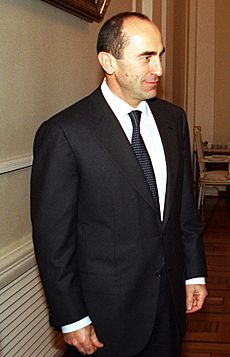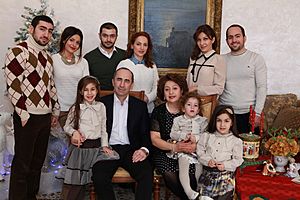Robert Kocharyan facts for kids
Quick facts for kids
Robert Kocharyan
|
|
|---|---|
| Ռոբերտ Քոչարյան | |
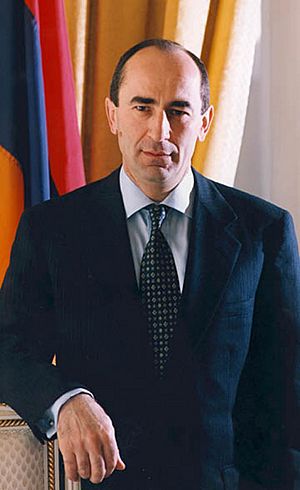
Official portrait, c. 1998
|
|
| 2nd President of Armenia | |
| In office 9 April 1998 – 9 April 2008 Acting: 4 February – 9 April 1998 |
|
| Prime Minister | Armen Darbinyan Vazgen Sargsyan Aram Sargsyan Andranik Margaryan Serzh Sargsyan |
| Preceded by | Levon Ter-Petrosyan |
| Succeeded by | Serzh Sargsyan |
| 6th Prime Minister of Armenia | |
| In office 20 March 1997 – 10 April 1998 |
|
| President | Levon Ter-Petrosyan |
| Preceded by | Armen Sarkissian |
| Succeeded by | Armen Darbinyan |
| 1st President of Nagorno-Karabakh | |
| In office 29 December 1994 – 20 March 1997 |
|
| Prime Minister | Leonard Petrosyan |
| Preceded by | Garen Baburyan (Acting) |
| Succeeded by | Leonard Petrosyan (Acting) |
| 2nd Prime Minister of Nagorno-Karabakh | |
| In office August 1992 – 29 December 1994 |
|
| President | Georgy Petrosyan (Acting) Karen Baburyan (Acting) |
| Preceded by | Oleg Yesayan |
| Succeeded by | Leonard Petrosyan |
| Personal details | |
| Born | 31 August 1954 Stepanakert, Nagorno-Karabakh Autonomous Oblast, Soviet Union |
| Political party | Independent |
| Other political affiliations |
Armenia Alliance |
| Spouse | Bella Kocharyan |
| Children | 3 |
| Alma mater | National Polytechnic University of Armenia |
| Signature | |
| Website | robertkocharyan.am |
Robert Sedraki Kocharyan (Armenian: Ռոբերտ Սեդրակի Քոչարյան; born on August 31, 1954) is an Armenian politician. He held important leadership roles in both Nagorno-Karabakh and Armenia. He was the President of the Nagorno-Karabakh Republic from 1994 to 1997. Before that, he served as its Prime Minister from 1992 to 1994. Later, he became the second President of Armenia from 1998 to 2008. He also served as Prime Minister of Armenia from 1997 to 1998.
During his time as President of Armenia, especially between 2001 and 2007, Armenia's economy grew a lot. This was partly because of a big increase in construction. Many people credit him with helping Armenia's economy grow. However, some critics say that during his presidency, there were issues with corruption.
After leaving the presidency, Kocharyan returned to politics following the Second Nagorno-Karabakh War in 2020. He led the Armenia Alliance in the 2021 Armenian parliamentary election. His alliance came in second place and became a part of the opposition in parliament.
Contents
Early Life and the Nagorno-Karabakh Conflict
Robert Kocharyan was born on August 31, 1954, in Stepanakert. This city is the capital of the Nagorno-Karabakh Autonomous Oblast. He finished his high school education in Stepanakert. From 1972 to 1974, he served in the Soviet Army. Kocharyan started his career in 1971 as an engineer at an electro-technical plant in Stepanakert. In 1982, he graduated with honors from the Karl Marx Polytechnic Institute in Yerevan. This school is now known as the National Polytechnic University of Armenia.
In the 1980s, he held various positions in the communist youth league and party in Nagorno-Karabakh. He was a leader in the Karabakh movement starting in February 1988. This movement aimed to transfer the Nagorno-Karabakh region from Azerbaijan to Armenia. After the movement's first organization ended, he started a new one called Miatsum ("Unification"). In 1989, he was elected to the Supreme Soviet of Soviet Armenia. In 1991, Kocharyan was elected to the Supreme Soviet of the newly formed Nagorno-Karabakh Republic (NKR).
When the Soviet Union broke apart, the Nagorno-Karabakh conflict turned into a full-scale war. Kocharyan played a role in the Capture of Shusha in May 1992. This was an important victory for the Armenian side during the war. In August 1992, he became the head of the State Defense Committee of the NKR. This group held all the executive power during the war. He also became the Prime Minister of the Nagorno-Karabakh Republic that year. Kocharyan helped coordinate the war efforts for the Nagorno-Karabakh Republic. The war ended with a ceasefire agreement in May 1994. Kocharyan was elected the NKR's first president on December 24, 1994. He was reelected by popular vote in November 1996.
Becoming Prime Minister of Armenia
On March 20, 1997, Robert Kocharyan left his role as President of the NKR. He was then appointed Prime Minister of Armenia by President Levon Ter-Petrosyan. In February 1998, President Ter-Petrosyan stepped down. This happened because Kocharyan and other ministers disagreed with Ter-Petrosyan's plan for peace in Karabakh. The peace plan suggested a "phased" settlement. This would involve Armenian forces leaving certain territories around Karabakh. In return, Armenia would receive security guarantees and blockades would be lifted.
Serving as President of Armenia
After Levon Ter-Petrosyan left office, Kocharyan was elected Armenia's second President. This happened on March 30, 1998. He won against Karen Demirchyan in an early election. Some observers noted issues during the election. There were also questions about whether Kocharyan was eligible to run. The Armenian constitution required candidates to be citizens and have lived in Armenia for ten years. Before becoming prime minister, Kocharyan lived in and was considered a citizen of Nagorno-Karabakh. Kocharyan was supported by the Republican Party of Armenia and the Armenian Revolutionary Federation. He made the latter party legal again early in his presidency.
In May 1999, Kocharyan's political group won many seats in the parliamentary elections. After this, Vazgen Sargsyan became prime minister, and Karen Demirchyan became the speaker of parliament. On October 27, 1999, Vazgen Sargsyan and Karen Demirchyan were killed along with six other government officials. This event is known as the 1999 Armenian parliament shooting. Five gunmen carried out the attack and took about fifty people hostage. Kocharyan himself talked with the attackers to get the hostages released.
The 2003 Election
The Armenian Presidential election in 2003 took place on February 19 and March 5. In the first round, no candidate won more than half of the votes. President Kocharyan received just under 50%. So, a second round was held. Kocharyan won against Stepan Demirchyan (Karen Demirchyan's son). Official results showed Kocharyan winning over 67% of the votes.
| Date | Favorable | Unfavorable |
|---|---|---|
| Nov 2006 | 33% | 66% |
| Mar 2007 | 40% | 51% |
| Jul 2007 | 42% | 52% |
| Sep 2007 | 42% | 52% |
| Survey%20of%20Armenian%20Public%20Opinion,%20October%2027-November%203,%202007.pdf Oct 2007 | 49% | 46% |
| Dec 2007 | 53% | 42% |
| Jan 2008 | 48% | 48% |
After both rounds, observers from the Organization for Security and Co-operation in Europe reported some issues. Demirchyan said the election was unfair and asked his supporters to protest. Many Armenians protested the results. However, Kocharyan was sworn in for his second term in April. The constitutional court supported the election results.
The 2008 Election
A presidential election was held in Armenia on February 19, 2008. President Kocharyan could not run for a third term. He supported Serzh Sargsyan, who was then the Prime Minister.
After the election results, protests began in Yerevan. These were organized by supporters of another candidate, Levon Ter-Petrosyan. On March 1, the police and military broke up the protests. President Kocharyan declared a 20-day state of emergency. This led to many arrests of opposition members.
Foreign Policy as President
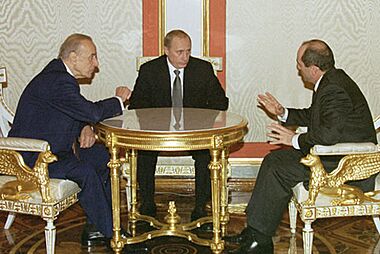
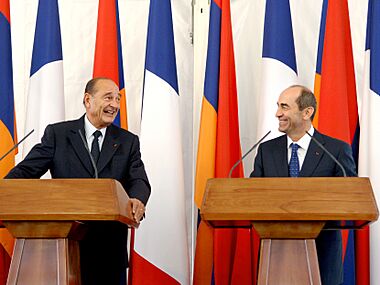
As President, Kocharyan continued to work towards a peaceful solution with Azerbaijani Presidents Heydar Aliyev and Ilham Aliyev. These talks were about the status of Nagorno-Karabakh. Kocharyan generally preferred a "package deal" settlement. This meant all issues, including the final status of Nagorno-Karabakh, would be solved in one agreement. In October 1999, Kocharyan became the first President of Armenia to visit Azerbaijan. He held talks with Heydar Aliyev at the border.
Kocharyan and Heydar Aliyev reportedly came very close to an agreement in April 2001. These talks were held in Key West and mediated by the US. Kocharyan later said that Aliyev was ready to recognize Karabakh as part of Armenia.
Talks between Kocharyan and Ilham Aliyev (Heydar Aliyev's son) took place in September 2004. They met in Astana, Kazakhstan. One idea discussed was for Armenian forces to leave territories next to Nagorno-Karabakh. In return, there would be votes (referendums) in Nagorno-Karabakh and Azerbaijan about the region's future. On February 10-11, 2006, Kocharyan and Aliyev met in Rambouillet, France. They discussed the main ideas for a settlement. This included troop withdrawals, international peacekeeping, and Nagorno-Karabakh's status.
Before the talks in France, co-chairmen of the OSCE Minsk Group were hopeful about an agreement. French President Jacques Chirac met with both leaders. He also hoped the talks would be successful. However, the Rambouillet talks did not lead to an agreement. Key issues like Nagorno-Karabakh's status were still debated. The next round of talks was in March 2006 in Washington, D.C. Russian President Vladimir Putin also encouraged both sides to resolve their disagreements.
In September 2006, Kocharyan sent a message for the 15th anniversary of the Nagorno-Karabakh Republic. He said that the people of Karabakh made their choice and defended their interests in the war. He added that they were building a free and independent state. He also said that Armenia and all Armenians should help strengthen Nagorno-Karabakh. They should also work for its international recognition.
After His Presidency
After his presidency, Robert Kocharyan remained involved in Armenian politics.
Return to Politics
During the Second Nagorno-Karabakh War in 2020, Kocharyan met with other former presidents of Armenia. They discussed the situation. In October 2020, Kocharyan and Levon Ter-Petrosyan asked Prime Minister Nikol Pashinyan for permission to go to Moscow. They wanted to act as special negotiators. Pashinyan agreed to their visit to meet Russian officials, but not as official negotiators. The visit did not happen because Kocharyan tested positive for COVID-19.
After Armenia's defeat in the war, Kocharyan joined other former presidents. They called for Nikol Pashinyan to resign. He supported Vazgen Manukyan to lead a temporary government. In January 2021, Kocharyan said he planned to participate in the next elections.
In March 2021, Armenia's Constitutional Court made a ruling. It stated that a criminal case against Kocharyan should be stopped. This was because the law he was being tried under did not match parts of the country's constitution. This ruling cannot be changed.
On May 7, 2021, Kocharyan confirmed he would participate in the June 2021 snap parliamentary elections. He formed a political alliance with the Armenian Revolutionary Federation and the Reborn Armenia party. This alliance was called Armenia Alliance, and Kocharyan led it. His alliance came in second place after Nikol Pashinyan's Civil Contract party. After the election, Kocharyan and the Armenia Alliance questioned the results. They asked for an investigation into claims of voter fraud. Kocharyan chose not to take his seat in the National Assembly. He continues to lead the Armenia Alliance from outside parliament.
His Views
Robert Kocharyan has always supported close ties between Armenia and Russia. He considers Vladimir Putin a friend and ally. In a 2019 article, he praised Russia's growing role in global politics. He also criticized what he saw as a pro-Western government in Armenia after the 2018 Armenian revolution.
He believes that relations between Turkey and Azerbaijan have become stronger. He sees this as part of a "pan-Turkist" movement. He thinks this movement is a direct threat to Armenia and Nagorno-Karabakh.
Kocharyan suggests that working with Russia on security is very important for Armenia. He believes there is no other choice for the country. He also mentioned the situation in northern Syria. He said it should be a clear lesson about the results of not thinking ahead in politics.
After Armenia's defeat in the 2020 war, he called for "full integration" with Russia. He supports Armenia joining the Russian-led Union State.
Personal Life
Robert Kocharyan is married to Bella Kocharyan. They have three children: Sedrak, Gayane, and Levon. All of their children were born in Stepanakert. Besides his native Armenian, Kocharyan also speaks Russian and English. In his memoirs, published in 2020, he shared that he had difficulty writing and reading in standard Armenian. He explained this is because many people in his homeland of Karabakh speak the local Karabakh dialect or Russian as their first language. He was baptized in the Armenian Apostolic Church in 1996. However, he has stated that he is not a religious believer.
Awards and Honors
 Republic of Artsakh:
Republic of Artsakh:
 Hero of Artsakh
Hero of Artsakh Order of Gregory the Illuminator
Order of Gregory the Illuminator Medal "For the Liberation of Shushi"
Medal "For the Liberation of Shushi"
 Georgia:
Georgia:
 Greece:
Greece:
 France:
France:
 Knight Grand Cross of the Legion of Honour
Knight Grand Cross of the Legion of Honour
 Lebanon:
Lebanon:
 Lithuania:
Lithuania:
 Palestine:
Palestine:
 Poland:
Poland:
 Order of the White Eagle (2004)
Order of the White Eagle (2004)
 Commonwealth of Independent States:
Commonwealth of Independent States:
 International Olympic Committee:
International Olympic Committee:
See also
 In Spanish: Robert Kocharián para niños
In Spanish: Robert Kocharián para niños


